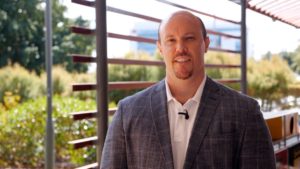A team of Griffith University researchers is redefining the future of limb loss rehabilitation with a ground-breaking innovation to monitor bionic limb stability.
Professor Laurent Frossard from Menzies Health Institute Queensland and Dr David Saxby from the School of Health Sciences and Social Work have won the $50,000 mobility prize in the 2021 Bionic Queensland Challenge for their non-invasive diagnostic device, Thomax 2.0.
“The Thomax 2.0 is designed to help rehabilitation work more effectively and safely by measuring the loading stress of a prosthesis on the stump of a limb in real-time,’’ Professor Frossard says.
“It integrates wearable loading sensors and personalised computational neuromusculoskeletal models for real-time animation of a digital twin of the residuum. It gives patient and the clinician feedback about what is actually going on inside the leg.
“Ultimately, we want to increase the mobility and quality of life of people with bionic limbs.”
Current problems with bone-anchored prosthetics include implant loosening, stability loss and infection that can seriously impede daily usage of the prosthesis and quality of life.
“If the loading isn’t right, the bone doesn’t grab the metal and the implant fails to stay in their body,’’ Dr Saxby said.

Dr David Saxby
“Then they are likely to experience other types of complications like infections, possibly give it up and return to a socket or they are going to have other types of complication.”
For Caroline Graydon, who lost her leg in a motorcycle accident in 2018, the ability to wear a bone-anchored prosthetic has been life-changing.
“The loading has to be gradual to give your bone time to adhere to the implant. So, the amount of weight I put through my right residual limb is equal to the weight I put through my left residual limb,’’ she said.
“Without this, I wouldn’t be able to walk.”
Bionics QLD CEO Robyn Stokes said Bionics Challenge 2021 had attracted the nation’s most talented scientists, engineers, clinicians and students who are redefining the future of healthcare.
“The judges felt Griffith’s innovation would really change the end game when it comes to the wearability of these devices,’’ she said.
The research team’s aim is to equip rehabilitation specialists with a device like the Thomax 2.0 enabling them to make tailored differential diagnosis of implant stability.
“It will revolutionise future thinking and practice of bionics rehabilitation,’’ Professor Frossard said.
The Bionics Challenge 2021 is a Queensland-led competition with national and state-level prizes for bionic discoveries to propel advanced healthcare solutions for those living with road accident trauma, chronic conditions, diseases, and disabilities.



